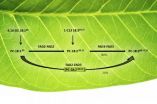(Press-News.org) Scientists from the University of the Philippines, Los Baños have discovered a new plant species with an unusual lifestyle — it eats nickel for a living — accumulating up to 18,000 ppm of the metal in its leaves without itself being poisoned, says Professor Edwino Fernando, lead author of the report. Such an amount is a hundred to a thousand times higher than in most other plants. The study was published in the open access journal PhytoKeys.
The new species is called Rinorea niccolifera, reflecting its ability to absorb nickel in very high amounts. Nickel hyperaccumulation is such a rare phenomenon with only about 0.5–1% of plant species native to nickel-rich soils having been recorded to exhibit the ability. Throughout the world, only about 450 species are known with this unusual trait, which is still a small proportion of the estimated 300,000 species of vascular plants.
The new species, according to Dr Marilyn Quimado, one of the lead scientists of the research team, was discovered on the western part of Luzon Island in the Philippines, an area known for soils rich in heavy metals.
"Hyperacccumulator plants have great potentials for the development of green technologies, for example, 'phytoremediation' and 'phytomining'", explains Dr Augustine Doronila of the School of Chemistry, University of Melbourne, who is also co-author of the report.
Phytoremediation refers to the use of hyperacccumulator plants to remove heavy metals in contaminated soils. Phytomining, on the other hand, is the use of hyperacccumulator plants to grow and harvest in order to recover commercially valuable metals in plant shoots from metal-rich sites.
INFORMATION:
The field surveys and laboratory work of the scientists are part of the research project funded by the Department of Science and Technology – Philippine Council for Industry, Energy, and Emerging Technology Research and Development (DOST-PCIEERD).
Original source
Fernando ES, Quimado MO, Doronila AI (2014) Rinorea niccolifera (Violaceae), a new, nickel-hyperaccumulating species from Luzon Island, Philippines. PhytoKeys 37: 1–13. doi: 10.3897/phytokeys.37.7136
New species of metal-eating plant discovered in the Philippines
2014-05-09
ELSE PRESS RELEASES FROM THIS DATE:
Plants' oil-desaturating enzymes pair up to channel metabolites
2014-05-09
UPTON, NY-Plant scientists at the U.S. Department of Energy's Brookhaven National Laboratory have found that certain enzymes responsible for desaturating fatty acids, the building blocks of oils, can link up to efficiently pass intermediate products from one enzyme to another. "Engineering these enzyme interactions to channel metabolites along desired metabolic pathways could be a new approach for tailoring plants to produce useful products," said Brookhaven biochemist John Shanklin, lead author on a paper reporting the results in the Journal of Biological Chemistry.
Getting ...
Leadless pacemaker showing promising results after 1 year
2014-05-09
Vivek Reddy, MD, Director of Arrhythmia Services for The Mount Sinai Hospital, reported his promising12-month follow-up data showing the world's first leadless pacemaker is demonstrating overall device performance comparable to conventional pacemakers. Dr. Reddy presented the one-year LEADLESS study data findings during his late-breaking clinical trial presentation on May 9 at Heart Rhythm 2014, the Heart Rhythm Society's 35th Annual Scientific Sessions in San Francisco, CA.
The LEADLESS study's long-term follow-up has evaluated 32 patients with a slowed heartbeat, bradycardia, ...
Scientists decode epigenetic mechanisms distinguishing stem cell function and blood cancer
2014-05-09
Researchers at Dartmouth's Norris Cotton Cancer Center have published results from a study in Cell Reports that discovers a new mechanism that distinguishes normal blood stem cells from blood cancers.
"These findings constitute a significant advance toward the goal of killing leukemia cells without harming the body's normal blood stem cells which are often damaged by chemotherapy," said Patricia Ernst, PhD, co-director of the Cancer Mechanisms Program of the Norris Cotton Cancer Center and an associate professor in Genetics at the Geisel School of Medicine.
The study ...
Study identifies mechanism by which intestinal enzyme maintains microbial balance
2014-05-09
Massachusetts General Hospital (MGH) investigators have identified the mechanism by which an enzyme produced in the intestinal lining helps to maintain a healthy population of gastrointestinal microbes. In their report in American Journal of Physiology – Gastrointestinal and Liver Physiology, the research team describes finding that intestinal alkaline phosphatase (IAP) promotes the growth of beneficial bacteria by blocking the growth-inhibiting action of adenosine triphosphate (ATP) – an action first described in this paper – within the intestine.
"We found that ATP ...
NASA sees system 90E just after earthquake hit Mexico's Guerrero State
2014-05-09
VIDEO:
This movie of imagery from NOAA's GOES-West satellite from May 7 at 14:15 UTC to May 9 at 14:15 UTC shows System 90E's progression and movement on land in southwestern...
Click here for more information.
As the dissipating tropical low pressure system known as System 90E continued rain on Guerrero State in southern Mexico, the U.S. Geological Survey reported a 6.4 magnitude earthquake occurred there on Thursday, May 8 around noon local time (1 p.m. EDT). NASA's Aqua satellite ...
Bioprinting a 3D liver-like device to detoxify the blood
2014-05-09
Nanoengineers at the University of California, San Diego have developed a 3D-printed device inspired by the liver to remove dangerous toxins from the blood. The device, which is designed to be used outside the body -- much like dialysis – uses nanoparticles to trap pore-forming toxins that can damage cellular membranes and are a key factor in illnesses that result from animal bites and stings, and bacterial infections. Their findings were published May 8 in the journal Nature Communications.
Nanoparticles have already been shown to be effective at neutralizing pore-forming ...
Rotational X-ray tracking uncovers hidden motion at the nanoscale
2014-05-09
Over the past two decades or so, there has been increasing interest and development in
measuring slow dynamics in disordered systems at the nanoscale, brought about in part from a demand for advancements in the food and consumer products industries.
Some of the techniques that have been developed over recent years to study the dynamic properties of these materials include X-ray photon correlation spectroscopy (XPCS) and speckle visibility spectroscopy (SVS). Both of these techniques however suffer from some fundamental limitations ranging from the use of only specialized ...
Study predicts adult obesity prevalence in almost all European countries by 2030
2014-05-09
Amsterdam, 9 May. Rates of obesity and overweight in both male and females are projected to increase in almost all countries of Europe by 2030, according to a statistical modelling study. However, the forecast rates vary throughout the 53 Euro-region countries, with projected male obesity levels ranging from 15% in the Netherlands and Belgium, to 47% in Ireland. The highest obesity prevalence in females was projected in Ireland (47%), and the lowest in Romania (10%).
The study, from investigators which included the WHO Regional Office for Europe, was presented at the ...
Colonization of Brazil by the cattle egret
2014-05-09
In recent years the cattle egret (Bubulcus ibis) has colonized American continent. Invasive species are a worldwide problem and studies are devoted to assess the damage they cause to local species populations. Thus, the process of colonization of a new territory that has continental dimensions such as Brazil offers an excellent opportunity to examine how non-native species disperse, adapt and survive. A new study of the colonization patterns of the cattle egret in Brazil, published in the open access journal NeoBiota, offers a new take on the study of alien species.
The ...
Research indicates coyote predation on deer in East manageable
2014-05-09
Coyotes are a major predator of white-tailed deer across the East, especially fawns born each spring, but wildlife managers nonetheless are able to stabilize and even grow deer herds, according to researchers in Penn State's College of Agricultural Sciences.
Coyotes -- Canis latrans -- are a relatively recent arrival to eastern North America, appearing first in the region in noticeable numbers in the 1970s. They are a significant source of deer mortality and most often prey on whitetails in the earliest months of their lives. Coyotes have long inhabited the American West.
With ...







